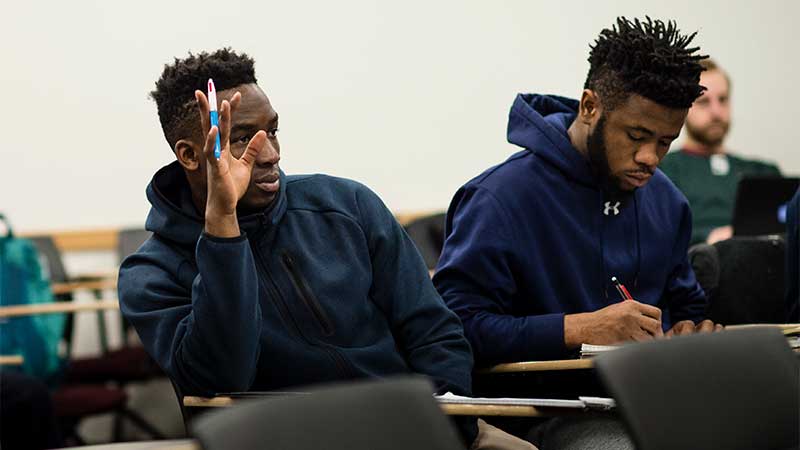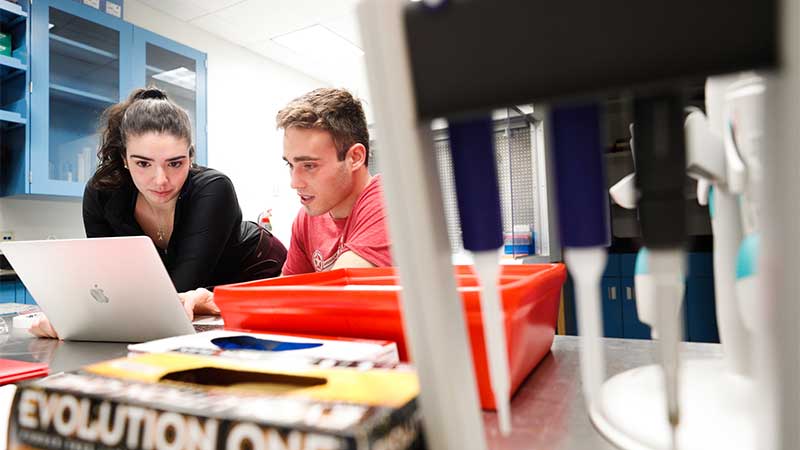We hear you!
We have gathered this data from individuals on campus and want to help everyone be heard. We've listed the comments we've heard here and are doing our best spread the word!
Students and professors were asked questions regarding the classroom environment for
LGBTQIA+ students.The interviews were conducted with people in various programs and
departments.
- Ask for pronouns and try not to misgender anyone.
- Be open to having hard conversations. This includes in class and outside of class. For example, if someone was uncomfortable with a comment made in class, be understanding and do your best to fix the mistake.
- Mention a historical person’s sexuality but try not to focus on it. Knowing queer people did some amazing things is great, but make sure you are focusing on the person’s achievements.
- If you mess up, apologize but don’t make it a huge deal. Especially with pronouns. If you misgender someone, apologize, correct yourself, and move on.
- Even if you do not understand someone’s identity, try to respect it.
- Information is always changing. Make sure to have updated terminology and be receptive if students correct you.
- If you do not know something, admit it and don’t pretend to be an expert. Terminology might change or a student might know a lot about a specific event you are teaching. No one cares if you do not know everything, but they do care if you teach inaccurate information.
- Try not to separate students by male/female. A lot of times, especially in certain science classes, students are split by gender. This can cause discomfort for nonbinary students or trans students who may not be out.
- Teach about the good and the bad. Learning about civil rights is great and definitely important. With that said, it is good to highlight all the positive events revolving around LGBTQIA+ people.
- Never refer to a trans person by their deadname. When talking about someone pre-transition, still refer to them by their current name and pronouns.
- Being LGBTQIA+ is complex. Do not try to simplify it.
- It is not always about what is being said but often what is not being said.
- Many people can relate to what is being taught, but oftentimes professors don't realize
that. They treat certain subjects as hypothetical issues that no one in the class
can relate to.
- Give trigger warnings. There is no harm in giving trigger warnings. Especially with
sexual topics. While that might not seem like a big deal to most college students,
many asexual students feel uncomfortable when brought up without warning. Plus, there
could be many reasons someone is uncomfortable with a certain topic.
- Do not assume anything based on how someone presents themselves. Someone could present
themselves as a stereotypical cisgender, heterosexual, but identify as LGBT+. The
opposite is also true. Someone who might seem stereotypically queer might be cisgender
and heterosexual.
- Talk to colleagues. They might have the answers to your questions, especially those in the same department.
- Be open to having a conversation with students and not only on the first day. Plus, sometimes it is good to remind them throughout the year.
- Ask for student feedback without forcing them to educate you.
- If you make a mistake, apologize immediately and then move on.
- When in doubt about pronouns, use the person’s name. Even in general, this can help get to know names of students better.
- Teach LGBTQIA+ content when relevant but do not force anything.
- Use recent, real-life examples and content from LGBTQIA+ outside Skidmore.
Terminology
*This terminology comes from the Human Rights Campaign and GLAAD with some slight changes. Not all terms are listed below, and some listed below are
not on the list from the Human Rights Campaign or GLAAD.*
- Asexual - Often called “ace” for short, asexual describes a person who experiences little
to no sexual attraction. Asexuality exists on a spectrum, and asexual people may experience
no, little, or conditional sexual attraction.
- Aromantic – Often called “aro” for short, aromantic describes a person who experiences little
to no romantic attraction. Aromantic exists on a spectrum, and aromantic people may
experience no, little, or conditional romantic attraction.
- Bisexual - A person emotionally, romantically, or sexually attracted to more than one sex,
gender, or gender identity though not necessarily simultaneously, in the same way,
or to the same degree. While bisexual is sometimes used interchangeably with pansexual,
the two are not the same.
- Cis-Gender - A term used to describe a person whose gender identity aligns with those typically
associated with the sex assigned to them at birth.
- Deadname – A term used to describe a name that someone no longer used. Often, a person’s deadname
was given to them at birth. While the term is most often used to describe transgender
individuals who have changed their name, cisgender people can also have a deadname.
- Demisexual/Demiromantic – A person who experiences romantic/sexual attraction, but only on certain occasions.
Often, demisexuals/demiromantics need to form a strong emotional bond before being
with a partner. Some people identify as both demisexual and demiromantic, but some
people only identify with one or the other. Demi can be used with any sexuality or
gender identity.
- Demi-Gender – A person who identifies closely with a binary gender but not completely. Used under
the nonbinary umbrella.
- Gay - A person who is emotionally, romantically, or sexually attracted to members of the
same gender. Men, women, and non-binary people use this term to describe themselves.
- Gender Identity - One’s innermost concept of self as male, female, a blend of both or neither – how
individuals perceive themselves and what they call themselves. One's gender identity
can be the same or different from their sex assigned at birth.
- Gender Non-Conforming - A broad term referring to people who do not behave in a way that conforms to the
traditional expectations of their gender, or whose gender expression does not fit
neatly into a category. While many also identify as transgender, not all gender non-conforming
people do.
- Gender-Queer - Genderqueer people typically reject notions of static categories of gender and embrace
a fluidity of gender identity and often, though not always, sexual orientation. People
who identify as "genderqueer" may see themselves as being both male and female, neither
male nor female, or as falling completely outside these categories.
- Gender Binary - A system in which gender is constructed into two strict categories of male or female.
Gender identity is expected to align with the sex assigned at birth and gender expressions
and roles fit traditional expectations.
- Gender Dysphoria - Clinically significant distress caused when a person's assigned birth gender is
not the same as the one with which they identify.
- Gender-Fluid - A person who does not identify with a single fixed gender or has a fluid or unfixed gender identity.
- Homophobia – The hatred of or discomfort with people who are attracted to members of the same sex.
- Lesbian - A person who identifies as female or non-binary who is emotionally, romantically, or sexually attracted to other women.
- Non-Binary - An adjective describing a person who does not identify exclusively as a man or a woman. Non-binary people may identify as being both a man and a woman, somewhere in between, or as falling completely outside these categories. While many also identify as transgender, not all non-binary people do. Non-binary can also be used as an umbrella term encompassing identities such as agender, bigender, genderqueer, or gender-fluid.
- Pansexual - Describes someone who has the potential for emotional, romantic, or sexual attraction to people of any gender though not necessarily simultaneously, in the same way, or to the same degree. While pansexual is sometimes used interchangeably with bisexual, the two are not the same
- Queer - A term people often use to express a spectrum of identities and orientations that are counter to the mainstream. Queer is often used as a catch-all to include many people, including those who do not identify as exclusively straight and/or folks who have non-binary identities. This term was previously used as a slur but has been reclaimed by many parts of the LGBTQ+ movement.
- Transgender - An umbrella term for people whose gender identity and/or expression is different from cultural expectations based on the sex they were assigned at birth. Being transgender does not imply any specific sexual orientation. Therefore, transgender people may identify as straight, gay, lesbian, bisexual, etc.
Terms for describing transgender/LGBTia+ identities/individuals
NO
YES
“He/she/they are a transgender” or “he/she/they is a gay”
“He/she/they are transgender” or “he/she/they is gay”
“When he was a girl” or “when she was a boy”
“Before he/she/they transitioned”
Refering to Someone using their deadname
Refering to someone using their name regardless of time reference
Born female/male
Assigned female/male at birth
Transgender and normal people
Transgender and cisgender people
Transvestite/transsexual
Trangender
Referring to being LGBT+ as a lifestyle
Referring to being LGBT+ as an identity
Gender neutral language/actions
|
NO YES Ladies and gentlemen Hello everyone/students/class Maternity or paternity leave Parental leave Husband/wife/girlfriend/boyfriend Partner/spouse Mother/father Parent Mr., Ms., or Mrs. Many gender non-conforming prefer the term Mx., but it is always best to ask. Splitting groups into male/female Splitting people into groups by hair color, birthday, height, eye color, etc. Both genders All genders Reinforcing the gender binary (“he/she”) in general speech Using “they” in general speech Men and women Masculine and feminine people
Forms for LBGTQIA+ inclusive teaching |
- To request funds for faculty development opportunities, click here.


